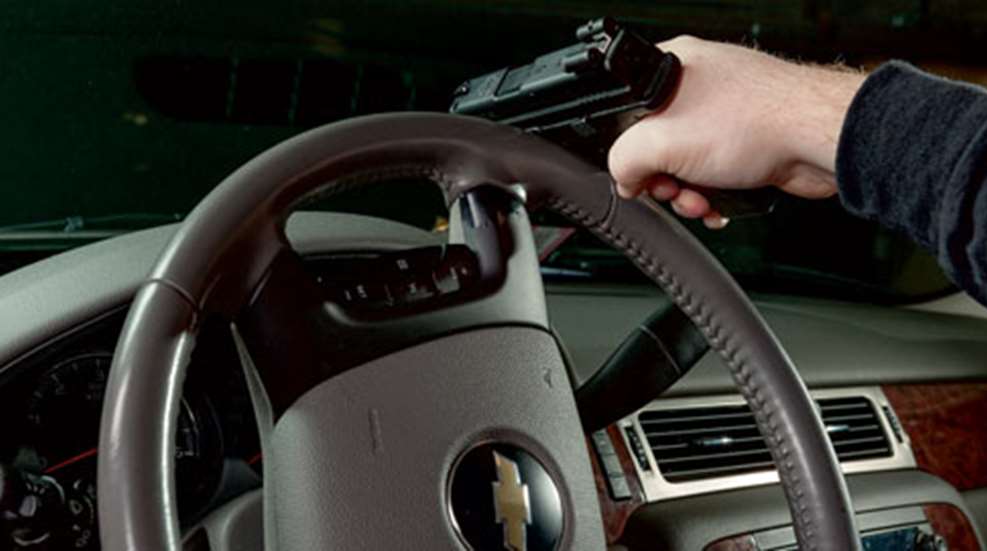
3/13/2013
Americans live in a culture of cars, spending many hours every week driving or riding in them, whether to and from the office, or across the country for vacation. After digesting commercials that emphasize the freedom of driving and the advances in vehicle safety features, it is easy to forget that threats other than weather and road conditions still exist, even after buckling up.
The feeling of security derived from driving is not unfounded, and the ability to just drive away from a bad situation cannot be overlooked. But what happens when escape is not an option? What should be done if an attack comes in a blocked parking garage, bumper-to-bumper traffic or after a breakdown? In those situations the law-abiding citizen is distracted and vulnerable—exactly what criminals look for in potential prey.
This article will provide some basic techniques and tactics for armed defense when facing down a threat outside or around a vehicle. Special thanks to Gunsite Academy and its expert instructors for these lessons and the development of the modern technique of the pistol.
First Things First, Draw The Gun
In an emergency situation, just having a gun does not make one safe; it is the practiced application of defensive firearm technique and force that saves lives, and once a threat is identified, it all starts with the draw. There are serious considerations to be examined with regard to drawing a firearm from the inside of a vehicle, chief among them is the most obvious—is the gun accessible?
Holsters designed for pedestrian concealed carry—such as kidney and small-of-the-back styles—quickly become hindrances when trying to draw from the seated position, confined between a car door and center console. So what kinds of holsters are best suited to such an environment? In the 1800s, when carrying revolvers came into vogue with mounted soldiers and ranchers, so too did the cross-draw holster, it provided a semi-seated individual better access to his gun than a strong-side hip or leg holster. Such holsters are still a viable option for car carry. As well, paddle holsters are good in that they can be easily moved or removed; shoulder rigs work the same whether sitting or standing; and separate holsters installed in the vehicle can provide customized accessibility. Personal preference and the vehicle’s configuration will determine the appropriate holster style and placement.
Although a violent confrontation can be over in seconds, safe handling of the firearm is still a priority. During the draw-stroke, especially under pressure and in a tight space, it could be easy to cover unintended targets with the gun’s muzzle. Practice is the only way to ensure that the presentation of a firearm does not endanger the user’s own body or those of his passengers. Once the pistol is accessible, practicing drawing from the holster will reveal potential obstacles and build the muscle memory needed to safely deploy the firearm. Finding the proper carry method and practicing its use are the first steps to improving defensive readiness within a vehicle.
Stop The Threat
Regardless of where the threat is coming from, discharging a firearm from inside a vehicle has repercussions not experienced in the outdoors or range-like environments. The audible blast will be perceptibly amplified, and possibly disorienting, because the passenger compartment is a small, enclosed space. Rather than dissipating into open air in all directions, the “bang” will be confined and will reverberate within the cabin. Another consideration is the blowback of glass and debris if firing through a window to stop an assailant. It is very likely that some shards could cause the shooter injury, especially to vulnerable areas such as the eyes. Eye protection would obviously be helpful in such a situation, but in an armed encounter, some risks are unavoidable.
For most situations, using a one-handed shooting grip is going to facilitate the fast target acquisition required in a personal-defense engagement. Though potentially more stable, limited space makes it difficult to acquire a good two-handed shooting position and, with an assailant at close range, every second counts. Practicing one-handed firing will improve accuracy and confidence in preparation for short-distance defensive shooting.
A threat from the passenger side of a vehicle can put the defender at a distinct disadvantage—he must potentially maneuver safely around a passenger in order to engage. For the purpose of instruction, techniques will be explained from the driver’s position; however, all methods can be modified to address different arrangements. A good way to safely get on target is to present the firearm with the muzzle pointed well forward of the passenger—toward the passenger-side windshield for example—and rotate to the threat using an extended firing arm to keep the passenger behind the line of fire. If no riders are present, the firearm can be presented directly toward the target, though using the former technique in practice will promote safer handling in any event.
Engaging a threat on the driver’s side has its own challenges. Most people are right-handed and therefore shoot right-handed and wear their firearm on the “strong” side. A threat to the left side of a car means the driver must draw and present toward a target on the opposite side of his body. That can cause issues such as covering one’s own body with the muzzle or getting the firearm caught in the steering wheel. A fast and safe technique for engaging a driver’s-side threat begins with simultaneously placing the left hand flat over the chest and drawing with the right hand, presenting the muzzle toward the dashboard. Next, keeping the shooting arm bent and being sure not to cover one’s own legs, orient the muzzle toward the threat. Keeping the firearm between the steering wheel and body, push toward the threat until the firing hand is pressed against the left hand, over the chest.
Finally, tucking the shooting arm into one’s side will improve stability during firing. This compact shooting position makes it possible for the shooter to engage threats on his weak side without getting hung up or endangering himself. It is not possible, however, to use the pistol’s sights from this position, at least in the normal fashion, so accurate pointing is necessary to get shots on target. A laser trainer is an invaluable tool for practicing this technique as it allows the shooter to visually confirm his muzzle orientation when pointing.
Get Out Of The Vehicle
Once all immediate threats have been neutralized, it is time to secure the area, contact authorities, and plan for recovery or relocation. Unless the vehicle is able to drive on—in which case moving to a safe location supersedes all other actions—it will be necessary to exit the vehicle. It is likely that, to this point, the driver’s seat belt has not been removed. In order to maintain vigilance and avoid accidentally covering non-targets with the firearm, it should be unfastened without looking down or using the firing hand. A good technique is to use the left or non-firing hand to grip the seat belt at the chest and use it as a guide to slide down to the locking mechanism and release it. Still using the left hand, the seat belt can be removed from the driver’s body.
With the seat belt out of the way, the next step is to open the door. While continuing to scan, the driver can manipulate locks and latches with the non-firing hand. Using the outside leg, the door can be pushed and held open. Most vehicle doors will bounce back toward the closed position, especially if opened quickly or with force. Using a leg to push and hold a door open keeps hands free and prevents it from bouncing back and striking or distracting the driver. While exiting, it is important to maintain muzzle awareness. One technique for transitioning out of the vehicle safely is to use the top of the steering wheel as a guide for the firearm. Sliding the pistol over the wheel, with the muzzle toward the windshield, not only keeps the gun oriented in a safe direction, it also avoids getting hung up in the wheel or on the seat.
Whether surveying surroundings or engaging additional targets, it is important to know how to maneuver around the vehicle. A good starting point is understanding what parts of a vehicle can be used as cover—any object or obstacle that will stop a bullet. The best place to shelter behind a vehicle is the engine block, for most vehicles this is in the front, above or just forward of the front axle. The components in the engine are mostly made of steel and other metals that provide a sizable bullet-stopping area. The wheels are also effective cover because of their metallic construction as well as the fact that a straight-on shot would have to penetrate not one but two wheels in order to impact a far-side target. The main body of the car, to include the passenger compartment and trunk, can provide adequate concealment and a measure of protection but, because it is constructed largely of thin metal, glass and fabric, it should not be considered cover. High-velocity and heavier bullets will readily penetrate doors, panels and windows. In testing, .45 ACP projectiles were particularly devastating against an inoperable Buick Cutlass, and the fact that it is one of the most widely used cartridges in the United States is all the more reason to get behind the engine.
When moving around, the defender should maintain several feet of distance between himself and the vehicle. It is natural to want to hunker down against the vehicle for protection, but close proximity actually increases vulnerability to penetrating rounds and shrapnel. Also, the defender runs the risk of getting caught up on the vehicle as he maneuvers or banging into it, giving assailants an audible clue to his location. It is better to maintain some distance and maneuver tactically—crouching, using a shuffle step and “pie-ing” the corners of the vehicle. If the engagement should resume, the vehicle can provide a defender with some safer, though unorthodox, shooting positions. Kneeling behind the engine and leaning out to fire, and lying prone behind the wheels are both positions that take advantage of cover, expose as little of the body as possible and still provide stability for accurate shooting.
Preparing to defend oneself from or around a vehicle is a natural extension of the personal protection repertoire developed by responsible armed citizens. From the moment a firearm is drawn to when it is re-holstered, an armed defender that practices the fundamentals of shooting and utilizes the resources available is well equipped to keep himself and others safe—no matter where they are.





































